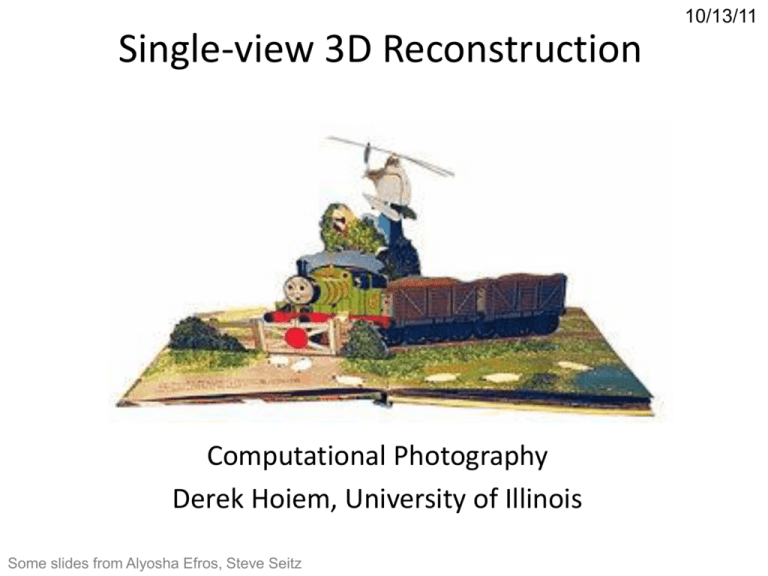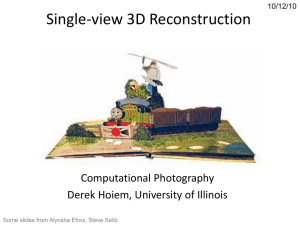ppt
advertisement

10/13/11 Single-view 3D Reconstruction Computational Photography Derek Hoiem, University of Illinois Some slides from Alyosha Efros, Steve Seitz Project 3 • Class favorites: vote please – “Favorites” will be presented next Thurs Next Tuesday • I’m out of town • Kevin Karsch is talking about physically grounded image editing, including inserting 3D objects into photographs 10/04/2011 Take-home question Suppose we have two 3D cubes on the ground facing the viewer, one near, one far. 1. What would they look like in perspective? 2. What would they look like in weak perspective? Photo credit: GazetteLive.co.uk Take-home question 10/11/2011 Suppose you have estimated three vanishing points corresponding to orthogonal directions. How can you recover the rotation matrix that is aligned with the 3D axes defined by these points? – Assume that intrinsic matrix K has three parameters – Remember, in homogeneous coordinates, we can write a 3d point at infinity as (X, Y, Z, 0) VPy VPx Photo from online Tate collection . VPz Take-home question Assume that the camera height is 5 ft. – What is the height of the man? – What is the height of the building? 10/11/2011 Relation between field of view and focal length Field of view (angle width) Film/Sensor Width d fov 2 tan 2f 1 Focal length Dolly Zoom or “Vertigo Effect” http://www.youtube.com/watch?v=nAhGM2Fyl8Q How is this done? Zoom in while moving away http://en.wikipedia.org/wiki/Focal_length Dolly zoom (or “Vertigo effect”) Field of view (angle width) d fov 2 tan 2f 1 Film/Sensor Width Focal length width of object 2 tan fov 2 width distance Distance between object and camera Today’s class: 3D Reconstruction The challenge One 2D image could be generated by an infinite number of 3D geometries ? ? ? The solution Make simplifying assumptions about 3D geometry Unlikely Likely Today’s class: Two Models • Box + frontal billboards • Ground plane + non-frontal billboards “Tour into the Picture” (Horry et al. SIGGRAPH ’97) Create a 3D “theatre stage” of five billboards Specify foreground objects through bounding polygons Use camera transformations to navigate through the scene Following slides modified from Efros The idea Many scenes (especially paintings), can be represented as an axis-aligned box volume (i.e. a stage) Key assumptions • All walls are orthogonal • Camera view plane is parallel to back of volume How many vanishing points does the box have? • Three, but two at infinity • Single-point perspective Can use the vanishing point to fit the box to the particular scene Fitting the box volume • User controls the inner box and the vanishing point placement (# of DOF???) • Q: What’s the significance of the vanishing point location? • A: It’s at eye (camera) level: ray from COP to VP is perpendicular to image plane – Under single-point perspective assumptions, the VP should be the optical center of the image Example of user input: vanishing point and back face of view volume are defined High Camera Example of user input: vanishing point and back face of view volume are defined Low Camera Comparison of how image is subdivided based on two different camera positions. You should see how moving the box corresponds to moving the eyepoint in the 3D world. High Camera Low Camera Another example of user input: vanishing point and back face of view volume are defined Left Camera Another example of user input: vanishing point and back face of view volume are defined Right Camera Comparison of two camera placements – left and right. Corresponding subdivisions match view you would see if you looked down a hallway. Left Camera Right Camera Question • Think about the camera center and image plane… – What happens when we move the box? – What happens when we move the vanishing point? 2D to 3D conversion • First, we can get ratios left right top vanishing point back plane bottom 2D to 3D conversion Size of user-defined back plane determines width/height throughout box (orthogonal sides) Use top versus side ratio to determine relative height and width dimensions of box Left/right and top/bot ratios determine part of 3D camera placement left right top camera pos bottom Depth of the box • Can compute by similar triangles (CVA vs. CV’A’) • Need to know focal length f (or FOV) • Note: can compute position on any object on the ground – Simple unprojection – What about things off the ground? Homography 2d coordinates 3d plane coordinates A C A’ B’ D B C’ D’ Image rectification p p’ To unwarp (rectify) an image solve for homography H given p and p’: wp’=Hp Computing homography Assume we have four matched points: How do we compute homography H? Direct Linear Transformation (DLT) p' Hp w' u' p' w' v' w' h1 H h4 h7 h2 h5 h8 h3 h6 h9 0 0 uu vu u u v 1 0 h0 0 0 0 u v 1 uv vv v h1 h 2 h3 h4 h h5 h6 h7 h8 h 9 Computing homography Direct Linear Transform 0 0 u1u1 v1u1 u1 u1 v1 1 0 0 0 0 u1 v1 1 u1 v1 v1 v1 v1 h 0 Ah 0 0 0 0 u v 1 u v v v v n n n n n n n • Apply SVD: UDVT = A • h = Vsmallest (column of V corr. to smallest singular value) h1 Matlab h h h 1 2 3 h [U, S, V] = svd(A); 2 h H h4 h5 h6 h = V(:, end); h7 h8 h9 h9 Explanations of SVD and solving homogeneous linear systems Tour into the picture algorithm 1. Set the box corners Tour into the picture algorithm 1. Set the box corners 2. Set the VP 3. Get 3D coordinates – Compute height, width, and depth of box 4. Get texture maps – homographies for each face x Result Render from new views http://www.cs.cmu.edu/afs/cs.cmu.edu/academic/class/15463-f08/www/proj5/www/dmillett/ Foreground Objects Use separate billboard for each For this to work, three separate images used: – Original image. – Mask to isolate desired foreground images. – Background with objects removed Foreground Objects Add vertical rectangles for each foreground object Can compute 3D coordinates P0, P1 since they are on known plane. P2, P3 can be computed as before (similar triangles) Foreground Result Video from CMU class: http://www.youtube.com/watch?v=dUAtd mGwcuM Automatic Photo Pop-up Input Geometric Labels Cut’n’Fold 3D Model Ground Image Vertical Learned Models Sky Hoiem et al. 2005 Cutting and Folding • Fit ground-vertical boundary – Iterative Hough transform Cutting and Folding • Form polylines from boundary segments – Join segments that intersect at slight angles – Remove small overlapping polylines • Estimate horizon position from perspective cues Cutting and Folding • ``Fold’’ along polylines and at corners • ``Cut’’ at ends of polylines and along vertical-sky boundary Cutting and Folding • Construct 3D model • Texture map Results http://www.cs.illinois.edu/homes/dhoiem/projects/popup/ Input Image Cut and Fold Automatic Photo Pop-up Results Input Image Automatic Photo Pop-up Comparison with Manual Method [Liebowitz et al. 1999] Input Image Automatic Photo Pop-up (30 sec)! Failures Labeling Errors Failures Foreground Objects Adding Foreground Labels Recovered Surface Labels + Ground-Vertical Boundary Fit Object Boundaries + Horizon Final project ideas • If a one-person project: – Interactive program to make 3D model from an image (e.g., output in VRML, or draw path for animation) • If a two-person team, 2nd person: – Add tools for cutting out foreground objects and automatic hole-filling Summary • 2D3D is mathematically impossible • Need right assumptions about the world geometry • Important tools – Vanishing points – Camera matrix – Homography Next Class • Kevin Karsch will show his work that applies many ideas from this section (cutting, texture synthesis, projective geometry, etc.) • Next Thursday: start of new section – Finding correspondences automatically – Image stitching – Various forms of recognition





